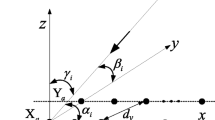Abstract
The problem of two dimensional direction of arrival estimation of coherent signals using three parallel uniform linear arrays is investigated. In the proposed method a pre-processing technique, forward and backward spatial smoothing is employed to resolve the coherency. Then the propagator method is exploited for estimating the two dimensional angles with automatic pairing for three parallel uniform linear arrays. Numerical simulations are done to show the efficacy of the proposed method. It validates the estimation accuracy, resolution and robustness of the proposed method.






Similar content being viewed by others
REFERENCES
I. Bekkerman and J. Tabrikian, “Target detection and localization using MIMO radars and sonars”, IEEE Trans. Signal Process. 54, 3873−3883 (2006).
K. T. Wong and M. D. Zoltowski, “Closed-form underwater acoustic direction finding with arbitrarily spaced vector hydrophones at unknown locations”, IEEE J. Ocean. Eng. 22, 566−575 (1997).
L. C. Godara, “Application of antenna arrays to mobile communications, part II: beam forming and direction of arrival considerations”, Proc. IEEE 8, 1195−1245 (1997).
P. Vallet, X. Mestre, and P. Loubaton, “Performance analysis of an improved MUSIC DoA estimator,” IEEE Trans. Signal Process. 63 (23), 6407−6422 (2015).
J. M. Kim, O. K. Lee, and J. C. Ye, “Compressive MUSIC: revisiting the link between compressive sensing and array signal processing”, IEEE Trans. Inf. Theory 58 (1), 278−301 (2012).
R. Roy and T. Kailath, “ESPRIT-estimation of signal parameters via rotational invariance techniques”, IEEE Trans. Acoust., Speech, Signal Process. 37, 984−995 (1989).
R. O. Schmidt, “Multiple emitter location and signal parameter estimation”, IEEE Trans. Antennas. Propag. 34, 276−280 (1986).
C. Qian, L. Huang, and H. C. So, “Computationally efficient ESPRIT algorithm for direction-of-arrival estimation based on Nystrom method”, Signal Process. 94, 74−80 (2014).
H. Chen, C. P. Hou, and Q. Wang, “Cumulants-based toeplitz matrices reconstruction method for 2D coherent DOA estimation”, IEEE Sensors J. 14, 2824−2832 (2014).
H. Tao, J. Xin, and J. Wang, “Two dimensional direction estimation for a mixture of non-coherent and coherent signals”, IEEE Trans. Signal Process. 63, 318−332 (2015).
T. Q. Xia, Y. Zheng, Q. Wan, and X. G. Wang, “2D angle of Arrival Estimation with Two Parallel Uniform Linear Arrays for Coherent Signals,” in Proc. IEEE Radar Conference, Waltham, Massachusetts, Apr. 17–20,2007 (IEEE, New York, 2007), pp. 244–247.
E. Gonen, J. M. Mendel, and M. C. Dogan, “Applications of cumulants to array processing, part IV: Direction finding in coherent signals case”, IEEE Trans. Signal Process. 45, 2265–2276 (1997).
N. Yuen and B. Friedlander, “DOA estimation in multipath: An approach using fourth-order cumulants”, IEEE Trans. Signal Process. 45, 1253−1265 (1997).
P. Palanisamy, N. Kalyanasundaram, and P. M. Swetha, “Two-dimensional DOA estimation of coherent signals using acoustic vector sensor array”, Signal Process. 92, 19−28 (2012).
C. C. Yeh, J. H. Lee, and Y. M. Chen, “Estimating two dimensional angles of arrival in coherent source environment”, IEEE Trans. Acoust., Speech, Signal Process. 37, 153−155 (1989).
Y. M. Chen, “On spatial smoothing for two dimensional DOA estimation of coherent signals”, IEEE Trans. Signal Process. 45, 1689−1696 (1997).
T. J. Shan, M. Wax, and T. Kailath, “On spatial smoothing for direction-of-arrival estimation of coherent signals”, IEEE Trans. Acoust., Speech, Signal Process. 33, 806−811 (1985).
S. U. Pillai and B. H. Kwon, “Forward-backward spatial smoothing techniques for coherent signal identification”, IEEE Trans. Acoust., Speech, Signal Process. 37, 8−15 (1989).
C. Y. Qi, Y. L.Wang, and Y. S. Zhang, “Spatial difference smoothing for DOA estimation of coherent signals”, IEEE Signal Process. Lett. 12, 800−802 (2005).
W. Zhang, W. Liu, and J. Wang, “Joint transmission and reception diversity smoothing for direction finding of coherent targets in MIMO radar,” IEEE J. Sel. Topics Signal Process. 8, 115−124 (2014).
H. Chen, C. Hou, and Q. Wang, “Improved azimuthal elevation angle estimation algorithm for three parallel uniformlinear arrays”, IEEE Antennas Wireless Propag. Lett. 14, 329−332 (2015).
N. Tayem and H. M. Kwon, “Azimuth and elevation angle estimation with no failure and no eigen decomposition”, Signal Process. 86, 8−16 (2006).
Z. Zheng, G. Li, and Y. Teng, “2D DOA estimator for multiple coherently distributed sources using modified propagator”, Circuits Syst. Signal Process. 31, 255−270 (2012).
S. Marcos, A. Marsal, and M. Benidir, “The propagator method for source bearing estimation”, Signal Process. 42 (2), 121−138 (1995).
J. Li, X. Zhang, and H. Chen, “Improved two-dimensional DOA estimation algorithm for two-parallel uniform linear arrays using propagator method”, Signal Process. 92, 3032−3038 (2012).
Y. Wu, G. Liao, and H. C. So, “A fast algorithm for 2D direction-of-arrival estimation”, Signal Process. 83, 1827−1831 (2013).
Y. Y. Dong, C. Dong, and J. Xu, “Computationally efficient 2D DOA estimation for L-shaped array with automatic pairing”, IEEE Antennas Wireless Propag. Lett. 15, 1669−1672 (2016).
R. T. Williams, S. Prasad, A. K. Mahalanabis, and L. H. Sibul, “An improved spatial smoothing technique for bearing estimation in a multipath environment”, IEEE Trans. on Acoustics, Speech, and Signal Process. 36, 425−432 (1988).
Author information
Authors and Affiliations
Corresponding author
Rights and permissions
About this article
Cite this article
Gowri, K., Palanisamy, P. Two Dimensional Direction of Arrival Estimation Algorithm for Coherent Signals Using Three Parallel Uniform Linear Arrays. J. Commun. Technol. Electron. 64, 1383–1390 (2019). https://doi.org/10.1134/S106422691912009X
Received:
Revised:
Accepted:
Published:
Issue Date:
DOI: https://doi.org/10.1134/S106422691912009X




